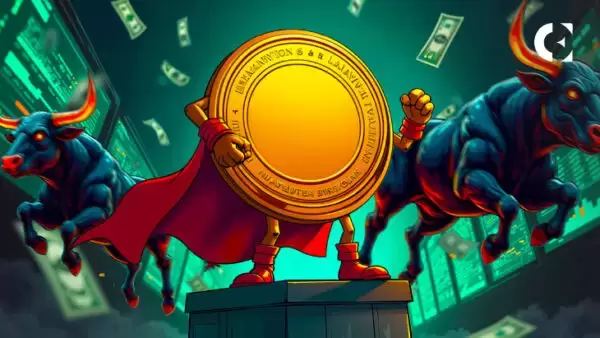 |
|
 |
|
 |
|
 |
|
 |
|
 |
|
 |
|
 |
|
 |
|
 |
|
 |
|
 |
|
 |
|
 |
|
 |
|
Cryptocurrency News Articles
Bitcoin exchange-traded products may have fundamentally altered the concept of a crypto “altseason.”
Mar 11, 2025 at 09:00 pm
This article explores how Bitcoin exchange-traded products may have fundamentally altered the concept of a crypto “altseason.”

Bitcoin exchange-traded products may have fundamentally altered the concept of a crypto “altseason.”
For years, the crypto market followed a familiar rhythm, a near-predictible dance of capital rotation. Bitcoin BTCUSD surged, bringing mainstream attention and liquidity, and then the floodgates opened to altcoins. Speculative capital rushed into lower-cap assets, inflating their values in what traders euphorically deemed “altseason.”
However, once taken for granted, this cycle shows signs of a structural collapse.
Spot Bitcoin exchange-traded funds (ETFs) have shattered records, funneling $129 billion in capital inflows in 2024. This has provided unprecedented access to Bitcoin for both retail and institutional investors, yet it has also created a vacuum, sucking capital away from speculative assets. Institutional players now have a safe, regulated way to gain exposure to crypto without the Wild West risks of the altcoin market. Many retail investors are also finding ETFs more appealing than the perilous hunt for the next 100x token. Well-known Bitcoin analyst Plan B even traded in his actual BTC for a spot ETF.
The shift is happening in real time, and if the capital remains locked in structured products, altcoins face a diminishing share of market liquidity and relevance.
Is the altseason dead? The rise of structured crypto exposure
Bitcoin ETFs offer an alternative to chasing high-risk, low-cap assets, as investors can access leverage, liquidity and regulatory clarity through structured products. The retail crowd, once a major driver of altcoin speculation, now has direct access to Bitcoin and Ether (ETH) ETFs, vehicles that eliminate self-custody concerns, mitigate counterparty risk and align with traditional investment frameworks.
Institutions have even greater incentives to sidestep altcoin risk. Hedge funds and professional trading desks, which once chased higher returns in low-liquidity altcoins, can deploy leverage through derivatives or take exposure via ETFs on legacy financial rails.
With the ability to hedge through options and futures, the incentive to gamble on illiquid, low-volume altcoins diminishes significantly. This has been further reinforced by the record $2.4 billion in outflows in February and arbitrage opportunities created by ETF redemptions, forcing a level of discipline into crypto markets that did not previously exist.
Will venture capital abandon crypto startups?
Venture capital (VC) firms have historically been the lifeblood of alt seasons, injecting liquidity into nascent projects and spinning grand narratives around emerging tokens.
However, with leverage being easily accessible and capital efficiency a key priority, VCs are rethinking their approach.
VCs strive to make as much return on investment (ROI) as possible, but the typical range is between 17% and 25%. In traditional finance, the risk-free rate of capital serves as the benchmark against which all investments are measured, typically represented by US Treasury yields.
In the crypto space, Bitcoin’s historical growth rate functions as a similar baseline for expected returns. This effectively becomes the industry’s version of the risk-free rate. Over the last decade, Bitcoin’s compound annual growth rate (CAGR) over the past 10 years has averaged 77%, significantly outperforming traditional assets like gold (8%) and the S&P 500 (11%). Even over the past five years, including both bull and bear market conditions, Bitcoin has maintained a 67% CAGR.
Using this as a baseline, a venture capitalist deploying capital in Bitcoin or Bitcoin-related ventures at this growth rate would see a total ROI of approximately 1,199% over five years, meaning the investment would increase nearly 12x.
While Bitcoin remains volatile, its long-term outperformance has positioned it as the fundamental benchmark for evaluating risk-adjusted returns in the crypto space. With arbitrage opportunities and reduced risk, VCs may play the safer bet.
In 2024, VC deal counts dropped 46%, even as overall investment volumes rebounded in Q4. This signals a shift toward more selective, high-value projects rather than speculative funding.
Web3 and AI-driven crypto startups are still drawing attention, but the days of indiscriminate funding for every token with a white paper may be numbered. If venture capital pivots further toward structured exposure through ETFs rather than a direct investment in risky startups, the consequences could be severe for new altcoin projects.
Meanwhile, the few altcoin projects that have made it onto institutional radars — such as Aptos, which recently saw an ETF filing — are exceptions, not the rule. Even crypto index ETFs, designed to capture broader exposure, have struggled to attract meaningful inflows, underscoring that capital is concentrated rather than dispersed.
The oversupply problem and the new market reality
The landscape has shifted. The sheer number of altcoins vying for attention has created a saturation problem. According to Dune Analytics, over 40 million tokens are currently in
Disclaimer:info@kdj.com
The information provided is not trading advice. kdj.com does not assume any responsibility for any investments made based on the information provided in this article. Cryptocurrencies are highly volatile and it is highly recommended that you invest with caution after thorough research!
If you believe that the content used on this website infringes your copyright, please contact us immediately (info@kdj.com) and we will delete it promptly.
-

-

- Macroeconomist and investment strategist Lyn Alden revises her Bitcoin (BTC) price prediction to $80,000
- Apr 19, 2025 at 08:20 pm
- Macroeconomist and investment strategist Lyn Alden revised her Bitcoin price prediction for 2025. Despite geopolitical and economic challenges, she predicted high numbers for the BTC price. She maintains that Bitcoin will likely close the year above its current value of approximately $85,00.
-

-

- Bitcoin (BTC) Withdrawals from Exchanges Point to Growing Investor Confidence
- Apr 19, 2025 at 08:15 pm
- According to recent data, more than 15,000 BTC have been withdrawn from exchanges over the past week. This points towards an increase in investor confidence as Bitcoin is moved out of exchanges into long-term storage instead of leaving it accessible on the exchanges.
-

-

-

-

-






























































